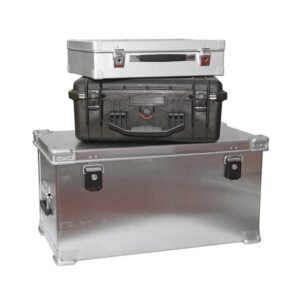
Different transit case colors can lead to different internal temperatures and conditions.
Professionals throughout the military, media, and medical fields require reliable protection of their sensitive equipment during transportation. One often-overlooked factor that can substantially impact the longevity and performance of your equipment is the color of the transit case used to house the equipment. The choice of color can play an important role in influencing the internal temperature of the case and potentially save your valuable assets from damage or malfunction. Creating a customized transit case with Packaging Strategies, Inc. involves selecting the best features for every part of the case. Transit case colors should be considered for their impact on the following concerns.
Absorption and Reflection of Solar Radiation
Transit case colors significantly affect how the case interacts with solar radiation. Darker colors, such as black or dark blue, tend to absorb more heat from the sun, causing the internal temperature to rise. This can be problematic, especially in hot climates or when transporting temperature-sensitive equipment like medical supplies or electronic devices.
PSI Pro Tip: Opt for lighter-colored transit cases, like tan or light gray, as they reflect more sunlight, helping to maintain a cooler internal environment.
Heat Retention
Dark-colored transit cases not only absorb heat from the sun but also tend to retain it for longer periods. This can lead to prolonged exposure to high temperatures, which may damage delicate electronic components or affect the efficacy of medical equipment.
PSI Pro Tip: Choose transit cases with lighter colors to reduce heat retention and minimize the risk of temperature-related issues.
Visibility and Temperature Control
In military operations, maintaining a low profile is crucial. Dark-colored cases may be less visible in certain environments but can also become heat traps. On the other hand, lighter-colored cases may be more visible but help in temperature control.
PSI Pro Tip: Consider the trade-off between visibility and temperature control when choosing a transit case color for military applications. Camouflage patterns can also be applied to lighter-colored cases to strike a balance and create a unique look.
Thermal Insulation
Some transit cases are designed with insulation materials to regulate internal temperatures. However, the color of the case can still influence its thermal properties. Light-colored cases can enhance the effectiveness of insulation by reflecting external heat, while dark colors may require more robust insulation to counteract heat absorption.
PSI Pro Tip: If you have specialized transit cases with insulation, ensure that the color complements its thermal properties for optimal performance.
Customized Case Solutions
Depending on your specific needs, you may want to consider custom transit case colors tailored to your industry. For example, medical professionals might prefer cases in sterile white, while military personnel may need cases in camo patterns to blend into their surroundings.
PSI Pro Tip: Work with a professional transit case manufacturer to explore custom color options that meet your requirements. Packaging Strategies, Inc. can help you determine the ideal transit case colors and properties for maximum protection and longevity.
DEPEND ON PACKAGING STRATEGIES FOR YOUR CUSTOM PACKAGING NEEDS
Packaging Strategies has assembled a team with over 100 years of experience in design, engineering, development, manufacturing, and sales. We created the Packaging Strategies Design and Technology Center to create and manufacture complete systems integration packages and container solutions of all sizes and materials for our clientele. Many of these clients are federal agencies or in the private sector. No matter what you need to carry, Packaging Strategies is sure to have the right case for the job. You can view our website here, and follow us on Facebook, Twitter, Flickr, and LinkedIn.
